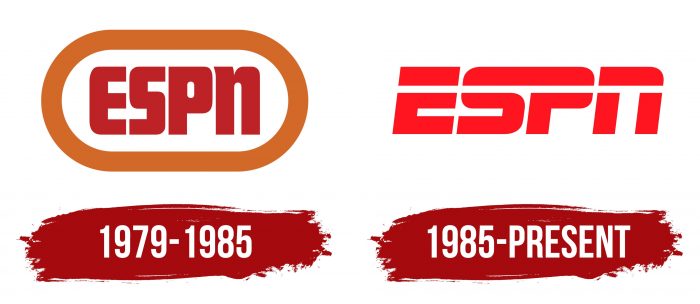The characteristics of the American sports broadcasting brand are reflected in the ESPN logo and its entire visualization. The right tilt symbolizes constant motion, while the red color represents the energy, passion, and aggression characteristic of all types of sports competitions.
ESPN: Brand overview
| Founded: | 1979 |
| Founder: | Bill Rasmussen, Scott Rasmussen |
| Headquarters: | Bristol, Connecticut |
| Website: | espn.com |
Meaning and History
The company has only had two logos throughout its existence: the debut and the current one. They differ significantly from each other, as designers changed both graphic and textual elements.
What is ESPN?
It is an American television network specializing in sports. ESPN stands for Entertainment and Sports Programming Network.
1979 – 1985
The first emblem was released on July 14, 1978. A year later, it became a full-fledged attribute of television programs. This happened on September 7, 1979. The initial version was a simple inscription, “ESPN.” The logo design is minimalist: red letters on a white background, surrounded by a wide orange oval.
1985 – today
The current version has been used since 1985. It is executed in the Stop font, which was developed in 1971 by designer Aldo Novarese. The authors reimagined the brand name, not taking anything from the previous version. The font was enlarged and slightly tilted to the right. The red letters were crossed by a wide white line, passing at the level of the upper bend of “S” and the inner letter space of “P.” This allowed for a completely new concept.
ESPN: Interesting Facts
ESPN stands for Entertainment and Sports Programming Network, and it’s a big deal when watching sports on TV or online.
- How It Started: ESPN was created on September 7, 1979, by Bill Rasmussen, his son Scott, and Ed Eagan. Their big idea was to show sports all day and all night, which was new back then.
- First Show: The first show on ESPN was “SportsCenter,” which is still running today. It provides news, highlights, and discussion of sports from around the world.
- New Ideas: ESPN came up with some cool new ways to watch sports, like replaying important moments quickly, showing news at the bottom of the screen, and having sports on TV all the time.
- Worldwide: ESPN didn’t just stay in one place; it grew to be worldwide, in over 200 countries, and sometimes in different languages like Spanish or French.
- Online Too: ESPN knows that the internet is important, so they have a website and an app where people can watch sports live, get news, and see scores whenever they want.
- Joining Disney: In 1996, Disney bought ESPN, which helped ESPN do even more, like reach more people and start new projects.
- More Than TV: ESPN tried other things, too, like restaurants themed around sports and magazines, but these days, it focuses more on digital stuff, like its website.
- ESPN+: In 2018, ESPN started a service where you pay to watch sports, original shows, and documentaries online, showing they’re keeping up with how people like to watch things now.
- “30 for 30”: One of the coolest things ESPN does is make documentaries about big sports stories. These shows are well-liked and tell deep stories about sports.
- Tech-Savvy: ESPN also uses new tech to make watching sports even better, like filming with drones, letting people watch in virtual reality, and using smart stats in their shows.
From just being a TV channel, ESPN has grown into a huge name in sports, showing games, making shows, and always coming up with new ideas to make watching sports fun and interesting.
Font and Colors
Both branding versions are based on the abbreviation Entertainment and Sports Programming Network. Moreover, both the first and second logos emphasize simplicity.
The current version contains an improved font similar to a graphic sign. It is characterized by modernity and dynamism, which is conveyed in the line crossing the word.
The color palette consists of a combination of red and white. The former is close to crimson and has an intense shade. Its task is to focus the audience’s attention on strength, passion, and brightness and maintain intensity at the peak of emotions. White, on the contrary, symbolizes purity and perfection.
In the print version, black is also used – light letters on a dark background. There is another version of the emblem, where the phrase “The total sports network” is placed under the name. It is written in uppercase.
ESPN color codes
| Red | Hex color: | #e52534 |
|---|---|---|
| RGB: | 229 37 52 | |
| CMYK: | 0 84 77 10 | |
| Pantone: | PMS 185 C |
FAQ
What does the ESPN logo mean?
The ESPN logo is tilted to the right, giving it a sense of movement. The dynamic effect is enhanced by the white horizontal line drawn across all the letters at the top. The red color symbolizes energy, passion, and aggression.
Who owns ESPN?
ESPN is divided between two owners. 20% of the shares belong to the transnational conglomerate Hearst Communications, Inc., and the remaining 80% to the media group The Walt Disney Company.
Who founded ESPN?
ESPN was founded by ophthalmologist Ed Egan, sociologist Scott William Rasmussen, and his father, William F. Rasmussen. They secured support from Bob Bays and jointly created the Entertainment and Sports Programming Network.
When was ESPN founded?
In 1978, the new brand Entertainment and Sports Programming Network was registered. The sports channel ESPN debuted on September 7, 1979.








